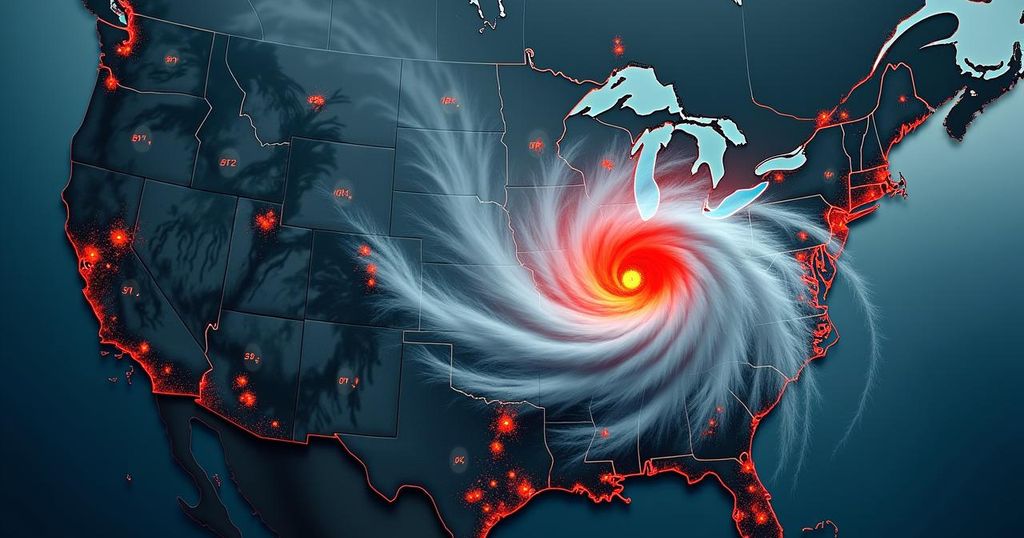Hurricane Helene: A Catastrophic Impact and Ongoing Monitoring of Storm Developments
Hurricane Helene has become the deadliest hurricane in the mainland U.S. since Hurricane Katrina, with a death toll of 180, surpassing Hurricane Ian’s 156 deaths in 2022. Helene ranks among the three deadliest hurricanes in the last 50 years. Currently, meteorologists are monitoring a potential tropical storm in the Gulf of Mexico, while Hurricane Kirk is strengthening in the Atlantic, expected to impact Europe, and Tropical Depression 13 is set to become Tropical Storm Leslie.
Hurricane Helene has tragically become the deadliest hurricane to impact the mainland United States since Hurricane Katrina, which occurred in 2005. As of October 2, the death toll associated with Hurricane Helene has reached 180, as reported by CNN. This figure surpasses the 156 deaths attributed to Hurricane Ian in 2022, placing Helene among the three deadliest hurricanes in the last fifty years, alongside Hurricane Katrina and Hurricane Maria from 2017. Looking back even further, Hurricane Camille, which struck in 1969 and claimed 259 lives primarily due to subsequent flash flooding, remains the only hurricane deadlier than Helene within the last six decades. The statistics derived from Helene include both direct and indirect fatalities. Direct deaths result from the immediate effects of the hurricane such as winds, rainfall, and storm surge, whereas indirect deaths can stem from various causes such as traffic incidents during evacuations or the exacerbation of medical emergencies due to power outages. Historical evaluations post-hurricanes Katrina and Maria considered “excess deaths,” a process comparing fatality rates in affected areas to projected rates had the storms not occurred. For instance, a George Washington University study estimated thousands of excess deaths following Hurricane Maria’s impact on Puerto Rico, with the official figure cited at 2,975. Currently, the National Hurricane Center is monitoring a broad low-pressure zone over Central America and adjacent waters, which may evolve into a tropical storm impacting the Gulf of Mexico. Although the potential for this system to develop into a hurricane as formidable as Helene appears minimal, a significant amount of rainfall is anticipated for the southern Gulf Coast and Florida. Forecasts indicate that a Central American Gyre could persist, typically known for producing substantial tropical storms, and though some years this formation can lead to powerful hurricanes, the prevailing upper-level winds seem unfavorable for such an occurrence this week. The latest modeling suggests a low probability (0% for two days and 40% for seven days) for cyclone development. In the Atlantic, Hurricane Kirk continues to gain strength, currently positioned safely from land, and is projected to follow a recurve path towards Europe while potentially escalating in intensity. Meanwhile, Tropical Depression 13 is set to become Tropical Storm Leslie, contributing to the active hurricane season and adjusting its path in response to Kirk’s outflows. This system holds promise for further development, given favorable environmental conditions.
Hurricane Helene’s devastating impact has spotlighted the ongoing dangers associated with tropical storms and hurricanes, particularly in regards to their deadly consequences and the complexities involved in assessing death tolls. Understanding both direct and indirect deaths linked to such disasters is crucial, as it highlights the various factors contributing to loss of life following storm events. Additionally, monitoring and forecasting play vital roles in preparing for potential hurricane developments, particularly in systems like the Central American Gyre, which can drive hurricane activity in the Gulf of Mexico. This context provides insight into the broader implications of climate change on weather patterns and storm intensity.
In summary, Hurricane Helene has emerged as a catastrophic event in recent U.S. history, surpassing the death toll of prior hurricanes and underscoring the significance of both direct and indirect fatalities in storm assessments. The evolving situation in the Gulf and Atlantic regions necessitates close monitoring and preparation, particularly with the possibility of developing tropical systems. As we observe these patterns, the interactions of environmental conditions greatly influence the behavior and impact of hurricanes, necessitating continued scrutiny and research into climate trends.
Original Source: yaleclimateconnections.org




Post Comment